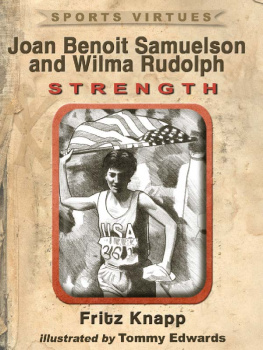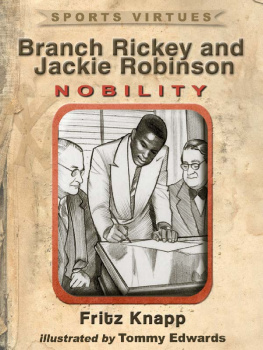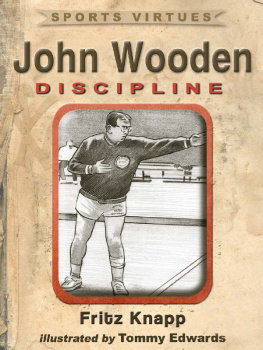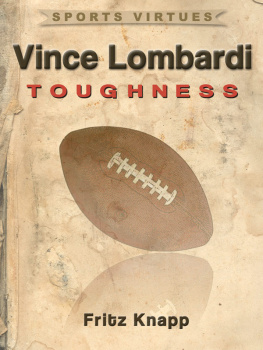Price World Publishing
www.PriceWorldPublishing.com
Scripture quotations are from the New Revised Standard Version Bible, copyright 1989 by the Division of Christian Education of the National Council of the Churches of Christ in the USA. Used by permission.
Copyright 2012 by Fritz Knapp
All rights reserved. Neither this book, nor any parts within it may be sold or reproduced in any form without permission.
Illustrations by Tom Edwards
Edited by Michael Wilt
eISBN: 9781619840386
Introduction
Their nicknames often seem to point to triumph: The Iron Horse, Captain Clutch, The Dominator, Mr. October, The Rocket, The Sultan of Swat, Air Jordan, Dr. J. But the true stories of many sports stars are much like those of any other human being. We all must, at some time or another, work and strive to overcome trouble, problems and hardship. Most of us do so on a smaller stageno lights, cameras, announcers, or postgame interviews. But there is much we can learn about how to live our own lives by studying the stories of great athletes who have overcome hard times and adversity.
The main characters in this series are well-known athletes and sports figures, men and women who have overcome personal misfortune through strength of character. Their stories inspire greatness in others. About ten years ago, I began to study athletes and the qualities that made them great. I was interested in more than their athletic abilities, impressive as those are in individuals who have made it to the top of their games. I was especially interested in their life abilities, the way they dealt with the variety of setbacks and struggles that all human beings encounter. In my study I read sports biographies by the dozens, and not just those of the most recent superstars. My reading took me as far back as the late 1800s. I found truly captivating accounts of athletes whose attitudes in their weak moments gave them more enduring legacies than they ever would have earned in athletic competition alone. As I entered some difficult personal times, these athletes became my friends and gave me a sense of hope that the struggles in my life would ultimately make me a stronger person.
I can personally identify with each athlete in this series. There is a part of me in every one of their stories. I have battled fatigue, failure and depression like U.S. Open golf champion Ken Venturi. I have had speech difficulties and low confidence like Amos Alonzo Stagg. My body has failed me at different times, as Gertrude Ederles and Lou Gehrigs bodies failed them. Despite lifes downside, though, I have been blessed with a source of strength that comes from deep within my soul and is a well-spring of incredible peace. This well has been fed, in part, by knowing otherssome personally and some through their storieswho fought hard to overcome their difficulties. My spirit has risen in the midst of trials, like an eagle in a storm soaring high above the mountains. But it is the Spirit that can turn tragedy into triumph, despair into hope, and defeat into victory. While the crises of life rage, Gods abundant grace is most present.
Each story in this series identifies a key personality trait demonstrated by a great athlete or sports figure in his or her struggle against adversity. Here you will read, for example, of the compassion of Gale Sayers and Brian Piccolo; the integrity of Arthur Ashe; the persistence of Althea Gibson; the wisdom of Happy Chandler. Through these and other stories, I hope you will find inspiration and a few new friends to help you along lifes journey. Get to know these people and you too will hear the lessons they teach. Let them be your mentors. Bring to your life the virtues described in these stories, and bring your own story into clearer perspective. Be true to who God made youa shining star in a dimming world. As St. Paul wrote, Adversity produces character, and character produces hope, and hope will not disappoint. Let adversity help turn you into the successful person God has created you to bea person of hope, a person of character.
STRENGTH
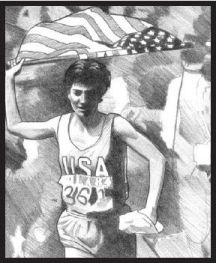
Joan Benoit Samuelson
and Wilma Rudolph
| STRENGTH: The capacity to manifest energy, to endure, and to resist. |
T wo Olympic runners in the second half of the twentieth century demonstrated how strength of body, mind and spirit can overcome limitations of many kinds. Joan Benoit Samuelson, a long distance phenomenon, and Wilma Rudolph, a lightning fast sprinter, showed their families, the world, and themselves just how far they could push themselves toward their goals when drawing upon all sources of strength.

All sports involve the expenditure of energy. Few sports, however, demand as much from its participants, both physically and mentally, as long distance running. Distance running presents a challenge to endure and to resist fatigue of monumental proportions. One of this sports shining examples is Joan Benoit Samuelson. She is the embodiment of strength.
Joan Benoit Samuelson was born in 1957. She is a downeasterner, having grown up in the state known best for its lobster harvest and rocky coastline: Maine. Its a place she has always loved and one that she credits for much of her success. She attributes the mental toughness that she has displayed over the years to having played sports under the adverse weather conditions typical of her home state in the fall and winter months. She trained so much in cold, windy, rainy and snowy weather that her desire to succeed as a distance runner had to be strong. Her determination served her well in competition. But just as important, it helped her rebound from several career-threatening injuries.
Growing up, Benoit Samuelson was a classic sportswoman. She played many diferent sports and played most of them well. She was intensely interested in skiing, but a leg injury shortened what may have been a prodigious career. She played field hockey, a sport her mother had played in college, and was quite good. Of course, she enjoyed running, but she also liked sports traditionally reserved for boys, such as baseball and basketball, and played pick-up games whenever she could get the boys to let her. She grew up accustomed to competing against boys, especially her three older brothers who were also athletic. Although she was excluded from certain sports because of her gender, track and field gave her an early opportunity to join forces with her male counterparts. The added competition helped her work that much harder. She thrived in the midst of the most intense challenges: inclement weather, formidable opponents, and bodily injuries. Adversity seemed to propel her to greater achievement.
In a running career that spanned some twenty years, Benoit Samuelson kept a frenetic pace, letting little get in the way of improving her track skills. She admits in her book Running Tide, Ive had to face the fact that mine is an obsessive personality: sometimes my goals become more important than good sense. I keep pushing myself until I literally drop.
And drop was what she nearly did when she ran in a collegiate meet with a fever of 104. She did not know, nor did she want to know, that she had mononucleosis. She did not want to let down her teammates and coaches, so instead of dropping out of the race, she finished in a dizzying, feverish fog. To this day, she has finished every race she ever started, no matter how badly she has felt while running. You call it pride, she writes, but its really fearIm afraid to relax my standards.
The greatest test of Benoit Samuelsons strength and ability to push herself came in the lead-up to the 1984 Summer Olympic Games. She sustained a knee injury during a twenty-mile run in South Portland, Maine and tried hard, by way of rest, medication, and shorter runs to avoid the inevitable surgery. Arthroscopic surgery was finally performed in April and an inflamed fibrous mass that was inhibiting movement was removed from her knee. Though the impediment had been removed, the question remained as to whether she could recover in time to not only run a marathon on May 12 at the Olympic Trials, but also to place in the top three so that she would qualify for the American team.
Next page
